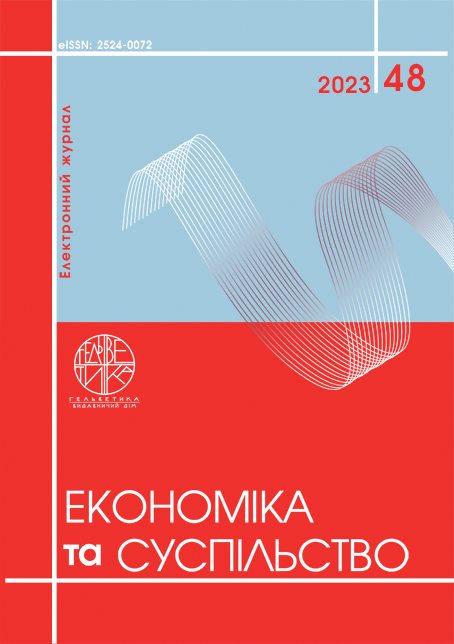THE UNIVERSITYES IMAGE AS A CRITERIA OF ITS ENGAGEMENT INTO THE INTERNATIONAL EDUCATIONAL PROGRAMS
Abstract
For a long period of time, the field of educational services was the property of the state's internal policy, a national institution, with specific national or regional traditions. Only from the 20th century. it is possible to note the beginning of active integration processes and the internationalization of education, as well as the creation of a single educational space. At the same time, international relations in the field of university education have significantly intensified, which is due to globalization processes. Despite the fact that there is a significant amount of research in the field of international exchange of educational services, there is still limited knowledge about the importance of the brand image of an educational institution and its trust on the part of consumers of educational services. That is why, in this study, we focused on determining the impact of advertising and communication in social networks on the brand image of an educational institution and the formation of trust in it before the stage of consumption; as well as its influence on the perception and attitude of education seekers towards service quality, satisfaction, and behavioral intentions at the post-consumption stage. Data were collected from 294 education seekers from Ukraine who chose programs of international exchange of educational services, and structural equation modeling was used to test the hypotheses. The results showed that advertising and communication in social networks have a positive effect on the perception of the University's brand image by the recipients of educational services (RES), which affects their trust in the brand of the educational institution (EI). It was also established that higher education institutions' perceived value and trust in the teaching staff of higher education institutions mediate the relationship between the quality of their services and satisfaction. In general, the study contributes to the development of scientific research by providing evidence and understanding of the specifics of the formation of EI branding and its impact on the perception and attitude of RES before and after training.
References
Gospodinova, Sonya. “Programa Erasmus+.” Europian Comision, 21 Mar. 2021. DOI: https://ec.europa.eu/commission/presscorner/detail/es/ip_21_1326
Butcher, Jim. “Real Tourism: Practice, Care and Politics in Contemporary Travel Culture.” Tourism Management, vol. 37, Aug. 2013, pp. 110–111.
Huei, Cham Tat, et al. “A Study of Brand Image, Perceived Service Quality, Patient Satisfaction and Behavioral Intention among the Medical Tourists.” Global Journal of Business and Social Science Review (GJBSSR) Vol. 2(2) 2014, vol. 2, no. 2, 16 Apr. 2014, pp. 32–43. DOI: https://doi.org/10.35609/gjbssr.2014.2.2(4)
Soltani, Ali, et al. “Exploring City Branding Strategies and Their Impacts on Local Tourism Success, the Case Study of Kumamoto Prefecture, Japan.” Asia Pacific Journal of Tourism Research, vol. 23, no. 2, 8 Dec. 2017, pp. 158–169. DOI: https://doi.org/10.1080/10941665.2017.1410195
Dugan, Elizabeth, et al. “Development of Abbreviated Measures to Assess Patient Trust in a Physician, a Health Insurer, and the Medical Profession.” BMC Health Services Research, vol. 5, no. 1, 3 Oct. 2005. DOI: https://doi.org/10.1186/1472-6963-5-64
Keller, Kevin Lane. “Conceptualizing, Measuring, and Managing Customer-Based Brand Equity.” Journal of Marketing, vol. 57, no. 1, Jan. 1993, pp. 1–22. DOI: https://doi.org/10.2307/1252054
Armstrong, Gary, and Philip Kotler. Marketing. Prentice Hall, 2007.
Zeithaml, Valarie A., et al. “The Behavioral Consequences of Service Quality.” Journal of Marketing, vol. 60, no. 2, Apr. 1996, p. 31. DOI: https://doi.org/10.2307/1251929
Kaplan, Andreas M., and Michael Haenlein. “Users of the World, Unite! The Challenges and Opportunities of Social Media.” Business Horizons, vol. 53, no. 1, Jan. 2010, pp. 59–68. DOI: https://doi.org/10.1016/j.bushor.2009.09.003
Bruhn, Manfred, et al. “Are Social Media Replacing Traditional Media in Terms of Brand Equity Creation?” Management Research Review, vol. 35, no. 9, 3 Aug. 2012, pp. 770–790. Emerald. DOI: https://doi.org/10.1108/01409171211255948
Butcher, Jim. “Real Tourism: Practice, Care and Politics in Contemporary Travel Culture.” Tourism Management, vol. 37, Aug. 2013, pp. 110–111. DOI: https://doi.org/10.1016/j.tourman.2013.01.011


